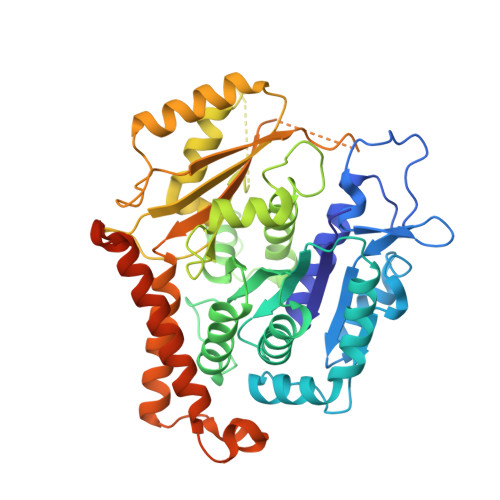The lattice as allosteric effector: structural studies of alphabeta- and gamma-tubulin clarify the role of GTP in microtubule assembly
Rice, L.M., Montabana, E.A., Agard, D.A.(2008) Proc Natl Acad Sci U S A 105: 5378-5383
- PubMed: 18388201
- DOI: https://doi.org/10.1073/pnas.0801155105
- Primary Citation of Related Structures:
3CB2 - PubMed Abstract:
GTP-dependent microtubule polymerization dynamics are required for cell division and are accompanied by domain rearrangements in the polymerizing subunit, alphabeta-tubulin. Two opposing models describe the role of GTP and its relationship to conformational change in alphabeta-tubulin. The allosteric model posits that unpolymerized alphabeta-tubulin adopts a more polymerization-competent conformation upon GTP binding. The lattice model posits that conformational changes occur only upon recruitment into the growing lattice. Published data support a lattice model, but are largely indirect and so the allosteric model has prevailed. We present two independent solution probes of the conformation of alphabeta-tubulin, the 2.3 A crystal structure of gamma-tubulin bound to GDP, and kinetic simulations to interpret the functional consequences of the structural data. These results (with our previous gamma-tubulin:GTPgammaS structure) support the lattice model by demonstrating that major domain rearrangements do not occur in eukaryotic tubulins in response to GTP binding, and that the unpolymerized conformation of alphabeta-tubulin differs significantly from the polymerized one. Thus, geometric constraints of lateral self-assembly must drive alphabeta-tubulin conformational changes, whereas GTP plays a secondary role to tune the strength of longitudinal contacts within the microtubule lattice. alphabeta-Tubulin behaves like a bent spring, resisting straightening until forced to do so by GTP-mediated interactions with the growing microtubule. Kinetic simulations demonstrate that resistance to straightening opposes microtubule initiation by specifically destabilizing early assembly intermediates that are especially sensitive to the strength of lateral interactions. These data provide new insights into the molecular origins of dynamic microtubule behavior.
- Department of Biochemistry and Biophysics and Howard Hughes Medical Institute, University of California, San Francisco, CA 94158-2517, USA.
Organizational Affiliation:

















